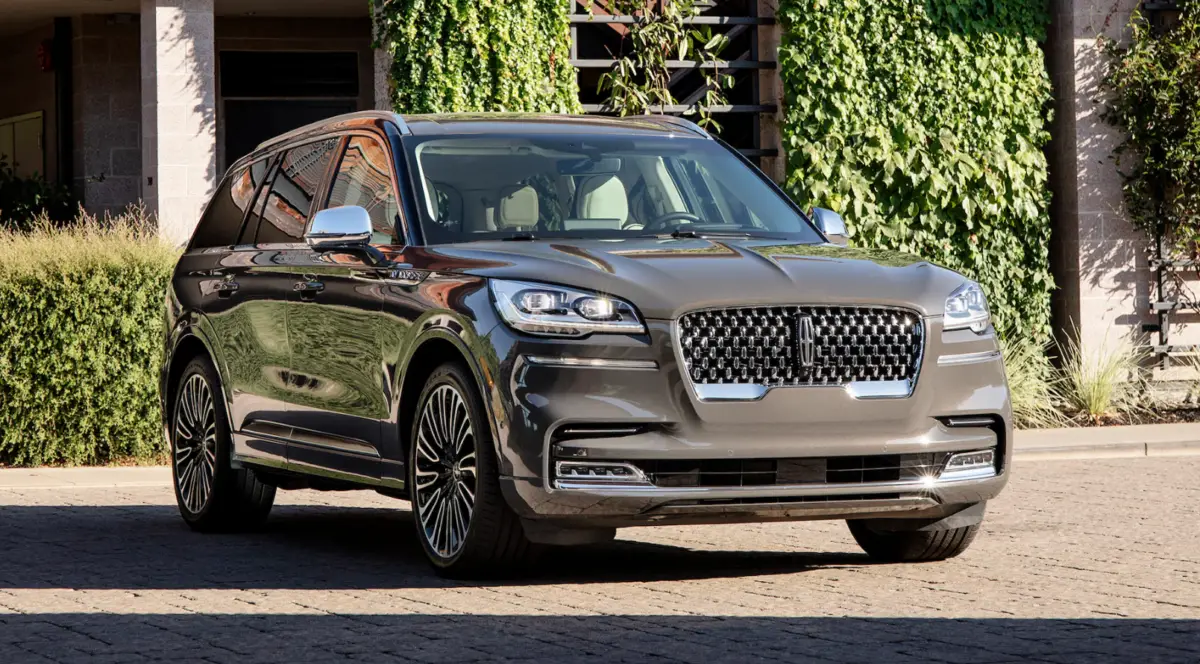2024 Lincoln Aviator Transmission Owner’s Manual
The performance and efficiency of a vehicle are determined by the transmission, a crucial component in the ever-changing field of automotive engineering. Let me introduce you to the 2024 Lincoln Aviator Transmission, a technologically advanced technical marvel. This transmission, which was created with creativity and perfection, completely transforms the driving experience by expertly balancing power delivery and fuel efficiency to provide drivers with an unmatched driving experience.
2023 – 2024 LINCOLN Aviator Specs, Price, Features, Mileage and Review
LINCOLN AUTOMATIC TRANSMISSION
WARNING: Apply the parking brake and make sure your vehicle is in park (P). Power the vehicle off and remove the keys or remote control whenever you leave your vehicle. Failure to follow this instruction could result in personal injury or death.
WARNING: Do not apply the brake pedal and accelerator pedal simultaneously. Applying both pedals simultaneously for more than a few seconds will limit engine performance, which may result in difficulty maintaining speed in traffic and could lead to serious injury.
Note: You cannot shift out of park (P) unless the intelligent access key is inside your vehicle.
Understanding Your Transmission Selector Positions
Your vehicle has an electronic transmission shifter. The transmission selector is on the center stack below the touchscreen.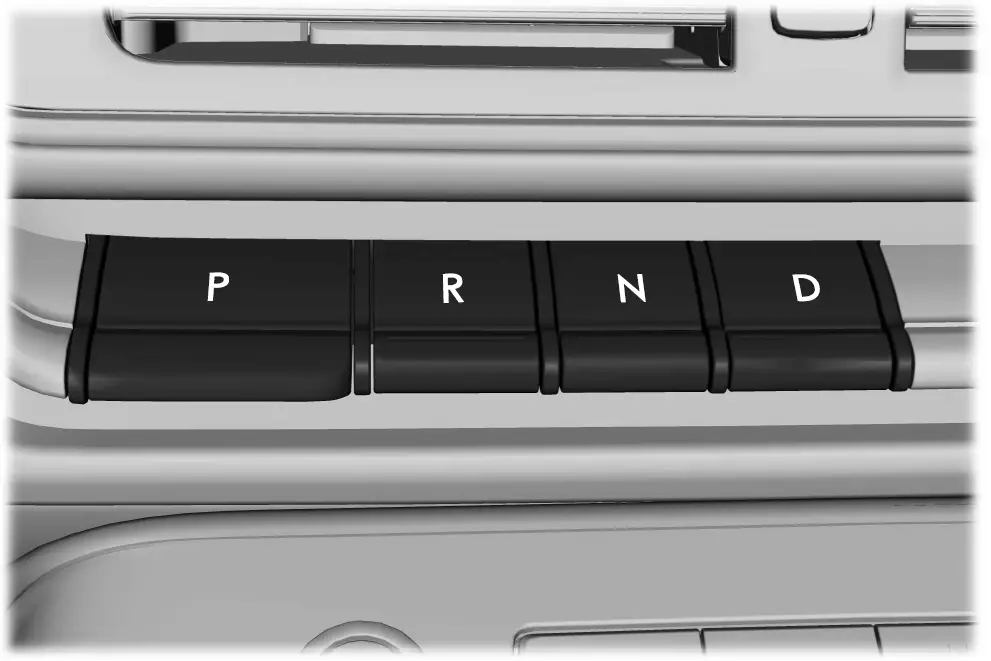
- P Park.
- R Reverse.
- N Neutral.
- D Drive.
The instrument cluster displays the current position.
Note: The position could illuminate on the transmission selector.
Park (P)
With the transmission in park (P), your vehicle locks the transmission and prevents the wheels from turning. Always come to a complete stop before putting your vehicle into and out of park (P). An audible tone sounds once you select park (P). When you switch the ignition off, your vehicle shifts into park (P). If you switch the ignition off while your vehicle is moving, the transmission first shifts into neutral (N) until it reaches a speed less than 3 mph (5 km/h) and then shifts into park (P). The electric parking brake could apply when you shift to park (P) without the brake pedal fully pressed. The electric parking brake applies when you shift to park (P) on large slopes. The electric parking brake releases with the drive away release function, or manually as described in the Releasing the Electric Parking Brake section.
Note: A warning tone sounds if you open the driver door and you have not shifted the transmission selector to park (P).
Reverse (R)
With the transmission selector in reverse (R), your vehicle moves backward. Always come to a complete stop before shifting into and out of reverse (R).
Neutral (N)
With the transmission selector in neutral (N), you can start your vehicle and it is free to roll. Hold the brake pedal down when in this position.
Drive (D)
Drive (D) is the normal driving position for the best fuel economy and smoothness. Shift the transmission selector to drive (D) to allow your vehicle to move forward and shift through the forward gears. The transmission shifts to the appropriate gear for optimum performance based on ambient temperature, road slope, vehicle load and your input.
Automatic Return to Park
Your vehicle shifts into park (P) when your vehicle is stationary and any of the following occur:
- You switch the vehicle off.
- You open the driver door with your seatbelt unlatched.
- You unlatch the driver seatbelt when the driver door is open.
Note: Do not use automatic return to park (P) when your vehicle is moving, except in an emergency.
Automatic return to park (P) may not work if the door ajar switch is malfunctioning.
See an authorized dealer if any of the following occur:
- Door ajar indicator does not illuminate with the driver door open.
- Door ajar indicator illuminates with the driver door closed.
- Transmission not in park message appears with the driver door closed, after you shift out of park (P). You unlatch the driver seatbelt when the driver door is open.
Stay in Neutral Mode User Manual
This mode keeps your vehicle in neutral (N) when you switch your vehicle off. Use this mode at an automatic car wash if you exit your vehicle, or switch your vehicle off.
Note: Automatic return to park (P) is delayed when your vehicle is in this mode.
Your vehicle could shift to park (P) after 30 minutes, or when the vehicle battery charge level is low. Prolonged use of this mode can cause the vehicle battery to run out of charge. Do not tow your vehicle in this mode. Failure to follow these instructions could result in vehicle damage not covered by the vehicle warranty.
Entering Temporary Neutral Mode
- Power your vehicle on.
- Bring your vehicle to a complete stop.
- Press and hold the brake pedal.
- Shift into neutral (N).
Note: An instructional message appears. - Press the neutral (N) button.
Note: A confirmation message appears when your vehicle enters the mode. - Release the brake pedal.
Note: Your vehicle is free to roll. - Switch your vehicle off.
Note: Do not tow your vehicle in this mode.
Note: The neutral (N) indicator on the transmission selector may flash in this mode.
Exiting Temporary Neutral Mode
- Press the brake pedal.
- Shift into park (P), or power your vehicle on and shift into drive (D) or reverse (R).
Manually Shifting Gears
The instrument cluster displays the current gear. The current gear flashes when your vehicle cannot shift into the requested gear. Your vehicle will not shift if the requested gear raises or lowers the engine speed beyond the limit. Your vehicle could shift when you fully press the accelerator or brake pedal.
Note: Prolonged driving with high engine speed could cause vehicle damage not covered by vehicle warranty.
Note: Drive modes could affect when the vehicle shifts into the requested gear.
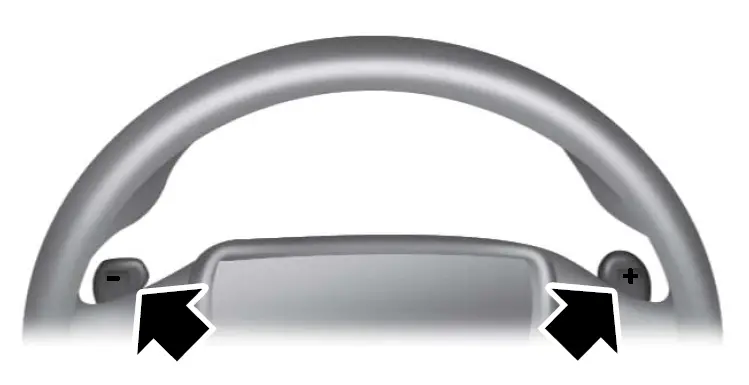
Manually Shifting Gears in Drive (D)
Use this feature to temporarily change gear.
Note: We recommend using this feature for engine braking or driving on hilly or mountainous roads.
- Pull any paddle to switch the feature on.
- Pull the right (+) paddle to upshift.
- Pull the left (-) paddle to downshift.
- Hold the + paddle for a few seconds to switch the feature off.
Note: The feature switches off after a short period of time if neither paddle is pulled.
Manual Park Release
WARNING: When doing this procedure, you need to take the transmission out of park (P) which means your vehicle can roll freely. To avoid unwanted vehicle movement, apply the parking brake prior to doing this procedure. Use wheel chocks if appropriate.
WARNING: If the parking brake is fully released, but the brake warning lamp remains illuminated, the brakes may not be working properly. Have your vehicle checked as soon as possible.
WARNING: Do not drive your vehicle until you verify that the stop lamps are working.
Use the manual park release to move your transmission from the park (P) position in the event of an electrical malfunction or emergency.
Activating the Manual Park Release Cable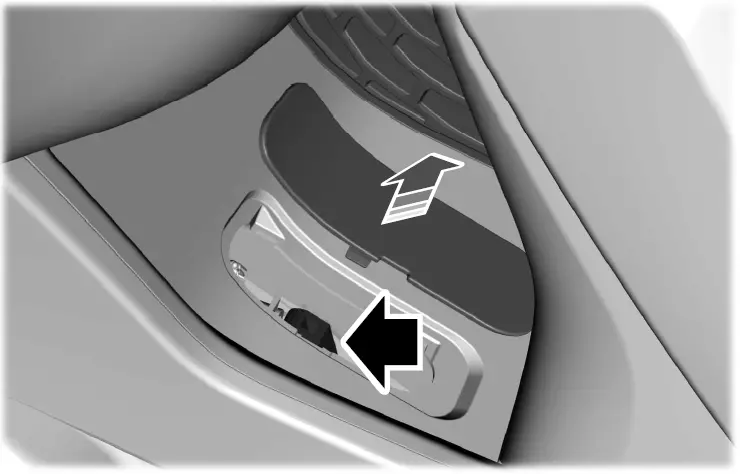
- Apply the parking brake.
Note: If the vehicle battery is dead, for example, no electrical power is available, you could require an external power source to apply the parking brake. - Using a flat head screwdriver 4.7 in (120 mm), carefully open the access cover under the arm rest console.
- Turn the vehicle ignition on without starting the vehicle. Press the push to start button without pressing the brake.
- Once in the driver seat, fully apply the brake pedal and hold. Do not release.
- Insert a screwdriver fully into the Manual Park Release lever slot, pull the Manual Park Release lever toward the rear until the detent in the slot pops up against the screwdriver. Allow 0.3 in (7 mm) of full upward travel of the detent, which locks in the park override mode, and you can remove the screwdriver. If done correctly, a message on the instrument cluster displays Park Not Available, Transmission Not in Park or Shift System Fault.
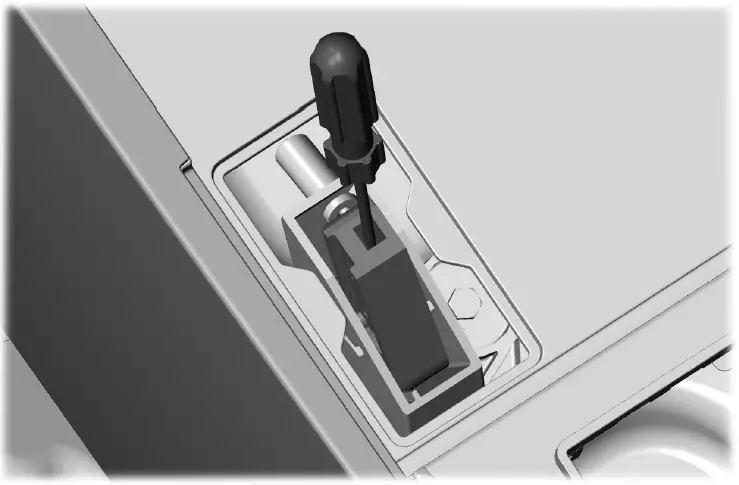
Note: A screwdriver tool longer than 4.7 in (120 mm) could hit the underside of the armrest console before you achieve full travel of the detent.
- With your foot still fully applied on the brake pedal, disengage the parking brake.
- Your vehicle remains in neutral (N) for emergency towing purposes.
- Switch off the ignition.
- Once it is safe to do so, and there is no risk of your vehicle rolling, disconnect the negative, black, battery cable from the battery.
Returning Your Vehicle to Normal Mode
- Once it is safe to do so, reconnect the negative, black, battery cable to the battery.
- Apply the parking brake.
Note: If the vehicle battery is dead, you could require an external power source to apply the parking brake. - Fully apply the brake pedal and hold, do not release.
- Insert the screwdriver fully into the Manual Park Release lever slot. Push the tool downwards. The system detent releases and the Manual Park Release lever moves forward, allowing the vehicle to go back into the park (P) position. Remove the screwdriver.
- Install the access cover.
- With your foot fully applied on the brake pedal, start your vehicle. Confirm that your vehicle is in the park (P) position and that the instrument cluster indicates park (P).
- If the instrument cluster does not display the park (P) position or there is a message stating Park Not Available, Transmission Not In Park or Shift System Fault, apply the parking brake before exiting your vehicle. Contact an authorized dealer.
If Your Vehicle Gets Stuck in Mud or Snow
If your vehicle gets stuck in the mud or snow, you can rock it out by shifting between forward and reverse gears, stopping between shifts in a steady pattern. Press lightly on the accelerator in each gear.
Note: Do not rock the vehicle if the engine is not at normal operating temperature or damage to the transmission could occur.
Note: Do not rock the vehicle for more than a minute or damage to the transmission and tires could occur, or the engine could overheat.
FAQs
The 2024 Lincoln Aviator is equipped with a state-of-the-art automatic transmission system.
The transmission typically features a multi-speed design, offering a smooth and efficient driving experience.
The transmission plays a crucial role in transferring power from the engine to the wheels, optimizing performance and fuel efficiency.
Yes, the transmission is designed to optimize gear ratios and shift points to maximize fuel efficiency without compromising performance.
The transmission’s responsive shifting and seamless operation contribute to the Aviator’s smooth and dynamic driving characteristics.
The Aviator typically comes with a standard transmission option, although higher trim levels may offer upgraded or performance-tuned transmissions.
Yes, the transmission is equipped with adaptive features that adjust shift patterns based on driving conditions and driver input.
Yes, the transmission is typically covered under Lincoln’s standard warranty, providing peace of mind to owners.
Regular maintenance, including fluid checks and changes, is essential to ensure the longevity and optimal performance of the transmission.
The transmission’s design and capabilities play a crucial role in the Aviator’s towing capacity, providing the necessary torque and control for towing trailers or other loads.
While primarily designed for smooth and efficient operation, performance enthusiasts may explore aftermarket tuning options to enhance the transmission’s capabilities.
Depending on the trim level and options, the transmission may feature performance-tuned shift mapping or paddle shifters for a sportier driving experience.
The transmission’s smooth and refined operation enhances the Aviator’s luxurious driving experience, minimizing noise and vibration for occupants.
While the stock transmission meets the needs of most drivers, aftermarket upgrades or replacements may be available for those seeking specific performance enhancements.
Useful Links
2023 – 2024 LINCOLN Aviator Specs, Price, Features, Mileage and Review

